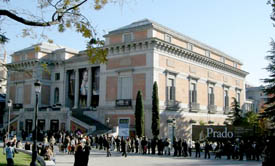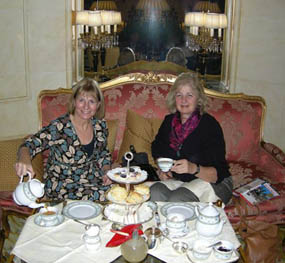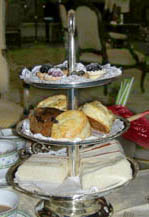A Portrait of Madrid
Madrid
by Sarah Shuckburgh
With its wonderful array of important paintings, the
Spanish capital is ideal for a jaunt with a fellow art-club
member, finds Sarah Shuckburgh.
Some people are members of book groups. I am in an art club.
It’s a brilliant invention: each month, the three members
agree on an exhibition, visit it independently and then
meet. Our discussions are brief, but the discipline is
effective – in a decade, we’ve seen about 100 exhibitions.

Recently Carol visited Madrid and loved it. Gila and I
decided that, in the interests of the club, we too deserved
a luxurious – and cultural – weekend away.
Conveniently, our bedroom at the Ritz overlooked the main
entrance of the Prado. From soft armchairs, we carried out
surveillance and made strategic plans about how to avoid
mile-long queues. On Saturday morning, we were at the door
as it opened. Luckily for us, the permanent collection was
almost deserted. As locals swarmed into the brand new wing,
designed by Moneo, with lofty foyer and two floors of
galleries for temporary exhibitions (currently a marvellous
collection of 19th century Spanish paintings), we made for
Velazquez. Of his astonishing portraits, our favourite was
the enchanting Dona Margarita, Philip IV’s daughter. She
married Emperor Leopold of Austria and died aged 20, but her
iconic face lives on, haunting, sombre and pale beneath a
halo of hair. Philip IV liked to drop into Velazquez’s
studio every day, and the painter celebrated this intimacy
by including himself in his famous Las Meninas painting –
which also features a young Dona Margarita.
 The Prado also has dozens of Goyas – the luscious Maja
(dressed and undressed), wonderful portraits, sketchy murals
and weirdly grotesque black paintings. There’s too much to
take in. Even limiting ourselves to Spanish art, we had to skim through El Greco, Murillo, Ribera and Zurbarán, but
Gila made me choose, in each room, one picture I wanted to
own, and one to burn. The Prado also has dozens of Goyas – the luscious Maja
(dressed and undressed), wonderful portraits, sketchy murals
and weirdly grotesque black paintings. There’s too much to
take in. Even limiting ourselves to Spanish art, we had to skim through El Greco, Murillo, Ribera and Zurbarán, but
Gila made me choose, in each room, one picture I wanted to
own, and one to burn.
After a restorative fruit juice in Moneo’s sleek black cafe,
we left the Prado and hopped on an open-topped sight-seeing
bus. The recorded commentary was hopelessly dull, with long
stretches of background music. Gila’s headphones didn’t
work, and an icy wind lashed our cheeks – but at least our
legs had a welcome rest.

We alighted near the Royal Palace, and tucked into dos
sandwiches calientes in the Café del Oriente, beneath an
equestrian statue of Philip IV. Invigorated, we toured
Charles III’s ornate and opulent state rooms. My favourite
was the Salon de Gasparini, Charles III’s dressing room – a
riot of rococo, with intricate chinoiserie walls, flamboyant
marble flooring, and an incredible ceiling of tangled vines
and lurid fruit. Gila’s favourite was the throne room, with
carved lions, gilded mirrors, Tiepolo frescoes, acres of
squiggly carpet woven by local craftsmen, and gigantic
chandeliers dangling almost to the floor. In every room,
baroque, rococo and neo-classicism combined to secure
18th-century Madrid’s status as a prestigious royal court.
We returned to the hotel at 5pm, an ideal hour for the Ritz
High Tea, with silver teapots, tea leaves with strainers,
and three-tier cake-stands piled with sandwiches, cakes,
pastries and warm scones with jam and cream.
While a handsome harpist played, Gila and I discussed which
king we preferred. Gila chose Philip IV, despite his
unappealingly pallid face and jutting Hapsburg jaw. During
his mid-17th century reign, Madrid replaced Seville as
Spain’s cultural capital, and the city entered a golden a ge,
with New World conquests, and the genius of Cervantes,
Murillo, Zurbarán and Velazquez. I favoured Charles III,
enlightened Bourbon monarch. He looked, according to Goya,
like a ruddy-faced yokel, but he brought Madrid to a peak of
splendour in the mid 18th century, founding the Prado and
its botanical gardens, bringing the city street lights and
sewage, and commissioning the spectacular Palacio Real. ge,
with New World conquests, and the genius of Cervantes,
Murillo, Zurbarán and Velazquez. I favoured Charles III,
enlightened Bourbon monarch. He looked, according to Goya,
like a ruddy-faced yokel, but he brought Madrid to a peak of
splendour in the mid 18th century, founding the Prado and
its botanical gardens, bringing the city street lights and
sewage, and commissioning the spectacular Palacio Real.
We managed High Tea only once, but at 6pm each day we
retired for a siesta. We undressed and got into our twin
beds, between freshly-laundered sheets, immaculately ironed
and with unbelievably high thread-counts. With the d in of
boulevard traffic silenced by quadruple-glazed windows, we
slept soundly until 10pm. Then we bathed, dressed and set
off for dinner. in of
boulevard traffic silenced by quadruple-glazed windows, we
slept soundly until 10pm. Then we bathed, dressed and set
off for dinner.
One evening, we walked through the old city centre, past
porticoed government buildings, and into the lively Plaza
Puerta del Sol, which lies at the geographical centre of
Spain. We skirted a political demonstration with armed
police, and crossed the dimly-lit Plaza Mayor, Madrid’s
400-year-old architectural gem. We were not the only
tourists at Botin, the World’s Oldest Restaurant (according
to the Guinness Book of Records), but the beamed ceilings,
patterned tiles and troubadours in doublet and hose made for
a memorable evening. We opted for local specialities –
gelatinous garlic-and-egg soup, a challenging hunk of fatty
suckling pig and then tasteless junket.
More successful gastronomically was our dinner at La Barraca.
Established a mere 70 years ago, this restaurant is
unpretentious and friendly, and our mixed paella with squid,
mussels, halibut, chicken and pork, was delicious.
Each night as we walked home at 1am, the streets still
thronged with pedestrians – families with smartly-dressed
infants, groups of teenagers and elderly couples in fur
coats. Flamenco dancers in polka-dot dresses smoked on
nightclub doorsteps, waiting to go on stage. When we reached
our room, we found our crisp monogrammed sheets folded back
and our scuffed shoes polished to an unrecognisable shine.
 Like the Prado, the Thyssen-Bornemisza Museum is within a
few steps of the Ritz, and we got there as it opened on
Sunday morning. Baron von Thyssen’s staggering private
collection is arranged chronologically, starting with the
early Renaissance, and an annexe houses further paintings
bought by his Spanish wife. The 20th century galleries were
full of Spanish masterpieces by Juan Gris, Picasso, Dali and
Miro - but in every room hung works impossible to ignore,
including a portrait of the Baron by Lucien Freud. Like the Prado, the Thyssen-Bornemisza Museum is within a
few steps of the Ritz, and we got there as it opened on
Sunday morning. Baron von Thyssen’s staggering private
collection is arranged chronologically, starting with the
early Renaissance, and an annexe houses further paintings
bought by his Spanish wife. The 20th century galleries were
full of Spanish masterpieces by Juan Gris, Picasso, Dali and
Miro - but in every room hung works impossible to ignore,
including a portrait of the Baron by Lucien Freud.
So much art, and so little time! We needed to get to the
Museo Sorolla before it closed at 3pm. Joaquín Sorolla, who
built this house in 1911 at the height of his fame, produced
tender and loving portraits of his wife and three children;
intimate open-air paintings of sunshine, water, wind and
light; beach scenes with dappled sunlight, billowing white
muslin and parasols, and portraits reminiscent of a
latterday Velazquez. From the courtyard garden, three lofty
studios lead to family rooms, all lined with his paintings,
which the brochure describes as luminist, naturalist,
orientalist, romanticist, impressionist and (a new one on
Gila and me) costumbrist. After his death in 1923, Sorolla’s
paintings went out of fashion, but Gila and I were smitten
by both paintings and man – all those portraits of his wife
and children a sure sign, we agreed, of a lovely husband.
 Many galleries close on Mondays, but luckily the Centro de
Arte Reina Sofia stays open. Sabatini’s 18th-century
hospital has been rebuilt, with glass lifts whizzing up the
outside, to house a mesmerising collection of 20th-century
art, including sculptures and charmingly naïve paintings by
Miro, Cubist collages by Madrid-born Juan Gris and surreal
works by Dali. Walls of Picasso studies lead to his gigantic
Guernica – a deeply disturbing painting, with curiously
entwined figures, distraught women, dismembered men, daggers
and eerie shafts of light. Many galleries close on Mondays, but luckily the Centro de
Arte Reina Sofia stays open. Sabatini’s 18th-century
hospital has been rebuilt, with glass lifts whizzing up the
outside, to house a mesmerising collection of 20th-century
art, including sculptures and charmingly naïve paintings by
Miro, Cubist collages by Madrid-born Juan Gris and surreal
works by Dali. Walls of Picasso studies lead to his gigantic
Guernica – a deeply disturbing painting, with curiously
entwined figures, distraught women, dismembered men, daggers
and eerie shafts of light.
Before heading to the airport, we had lunch at Café Gijón,
the last of Madrid’s great literary cafes, meeting place of
tertulia, Spanish forerunners of today’s book groups. The
café opened in 1888, and in its heyday, Mata Hari, Garcia
Lorca and Salvadore Dali were patrons. As we tucked into our
fish soup, we eyed a group of dishevelled men, smoking and
conversing intently. Were they members of a distinguished
literary tertulia? And would they recognise us as members of
a distinguished artistic tertulia?
Kirker Holidays
www.kirkerholidays.com
First published by the Telegraph
©SarahShuckburgh |